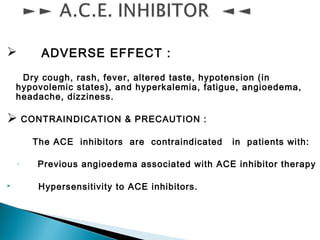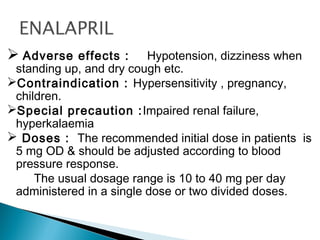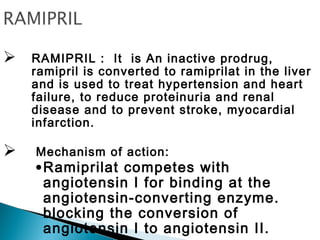new files upload for ace inhibitors in MRTCCT
- 1. Rasel Mahbub Dept of pharmacy Jagannath University
- 2. HYPERTENSION is defined as either a sustained systolic blood pressure (SBP) of greater than 140 mm Hg or a sustained diastolic blood pressure (DBP) of greater than 90 mm Hg. Hypertension results from increased peripheral vascular smooth muscle tone, which leads to increased arteriolar resistance and reduced capacitance of the venous system.
- 3. 1.ACE (Angiotensin Converting Enzyme)inhibitor: Captopril,Enalapril, Ramipril etc. 2.Angiotensin (AT1 Receptor) blocker : Losartan, Candesartan, Valsartan etc. 3.Calcium channel blocker : Verapamil, Diltiazem, Nifedipine etc. 4.Sympatholytic agent: Beta Adrenergic bocker : Propanolol, Atenolol,Metoprolol.
- 4. Alpha Adrenergic blocker : Prazosin,Terazosin. Beta & Alpha Adrenergic blocker : Labetalol, Carvedilol. Central Sympatholytic agent: Clonidine, Methyldopa. 5.Diuretics : .. Thiazide : Hydrochlorothiazide, Chlorothiazide. .. High ceiling{loop diuretics} : Furosemide. .. Potassium sparing: Spironolactone,Amiloride .. Osmotic diuretics:glycine,mannitol,urea ..CA inhibitor:Acetozolamide
- 5. 6.Direct Vasodilators : Arteriolar :Hydralazine,Minoxidil. Arteriolar & Venous : Sodium nitroprusside. 7.Adrenergic neurone blocker : Reserpine, Guanethidine
- 6. A.C.E.(Angiostensin converting enzyme) inhibitor is an agent which block the angiotensin converting enzyme which ultimately inhibit the conversion of Angiotensin-ɪɪ from Angiotensin-ɪ. Classification of ACE Inhibitor 1. Direct action but internalized metabolite to disulfide group.Ex. captopril 2. Prodrug (ester dicarboxylic acid) They have the effects when they are changed to active metabolized .Ex enalapril, benazepril, 3. Soluble in water and not change in the body Ex lisinopril
- 7. MECHANISM OF ACTION : The ACE inhibitors lower blood pressure by reducing peripheral vascular resistance. Block the ACE that cleaves angiotensin I to form the potent vasoconstrictor angiotensin II. ACE inhibitors decrease angiotensin II and increase bradykinin levels. ACE inhibitors also decrease the secretion of aldosterone, resulting in decreased sodium and water retention.
- 9. Angiotensin is a peptide hormone that causes vasoconstriction and a subsequent increase in blood pressure. It is part of the renin- angiotensin system, which is a major target for drugs that lower blood pressure. Angiotensin also stimulates the release of aldosterone, another hormone, from the adrenal cortex. Angiotensin is a alpha2 globulin with a m/w of 58000,it contains 452 amino acid and is continuosly snthesized by the liver
- 10. Bradykinin is a non a peptides those acts locally &produce pain also cause of Vasodilation Bronchoconstriction Increase vascular permeability Stimulate prostaglandin synthesis
- 11. The hormone acts mainly in the functional unit of the kidneys to aid in the conservation of sodium, secretion of potassium, water retention and to stabilize blood pressure. ... Aldosterone helps maintain blood pressure (BP) and water and salt balance in the body by helping the kidneys retain sodium and excrete potassium. aldosterone.>Na&water retention>increase CO>increase BP
- 12. Aldosterone also causes water to be reabsorbed along with sodium; this increases blood volume and therefore blood pressure. Thus, aldosterone indirectly regulatesblood levels of electrolytes (sodium, potassium and hydrogen) and helps to maintain the blood pH.
- 14. ADVERSE EFFECT : Dry cough, rash, fever, altered taste, hypotension (in hypovolemic states), and hyperkalemia, fatigue, angioedema, headache, dizziness. CONTRAINDICATION & PRECAUTION : The ACE inhibitors are contraindicated in patients with: ◦ Previous angioedema associated with ACE inhibitor therapy Hypersensitivity to ACE inhibitors.
- 15. ACE inhibitors should be used with caution in patients with: Impaired renal function. Hypovolemia or dehydration. THERPEUTIC USES :Used in patients with cardiac failure, renal disease or systemic sclerosis .It also used to treat diabetic nephropathy and left ventricular hypertrophy.
- 16. CAPTOPRIL : Mechanism of action: Captopril prevents the conversion of angiotensin I to angiotensin II by inhibition of ACE. Decreased plasma angiotensin II. Increased plasma renin activity (PRA) resulting from loss of negative feedback on renin release. Decreased aldosterone secretion. small increases in serum potassium with sodium and fluid loss.
- 17. Adverse effects : Cough due to increase in the plasma levels of bradykinin, angioedema, agranulocytosis, proteinuria, hyperkalemia, taste alteration, teratogenicity, acute renal failure and leukopenia. Contraindication : Hypersensivity,stenosis,renal impairment,pregnancy. Precaution : Lactation, severe CHF. Dose : 25 mg BD or 50 mg TDS. Clinical use: vasodilation and inhibition of some renal function activities .Used in Hypertension,Cardiac conditions such as post myocardial infarction and congestive heart failure.
- 18. Enalapril, an angiotensin-converting enzyme (ACE) inhibitor, is a prodrug which, when hydrolyzed by estarases to its active Enalaprilat. Mechanism of action: Enalaprilat competes with angiotensin I for binding at the angiotensin-converting enzyme, blocking the conversion of angiotensin I to angiotensin II. As angiotensin II is a vasoconstrictor and a negative- feedback mediator for renin activity, lower concentrations result in a decrease in blood pressure. Enalaprilat may also act on kininase II,that degrades the vasodilator bradykinin.
- 19. Pharmacokinetic data : Bioavailability - 60% (oral), Metabolism - hepatic (to enalaprilat), Half-life - 11 hours (enalaprilat), Excretion - renal. Clinical uses :Management of hypertension. In hypertensive patients with heart failure, postmyocardial infarction, high coronary disease risk etc.
- 20. Adverse effects : Hypotension, dizziness when standing up, and dry cough etc. Contraindication : Hypersensitivity , pregnancy, children. Special precaution :Impaired renal failure, hyperkalaemia Doses : The recommended initial dose in patients is 5 mg OD & should be adjusted according to blood pressure response. The usual dosage range is 10 to 40 mg per day administered in a single dose or two divided doses.
- 21. RAMIPRIL : It is An inactive prodrug, ramipril is converted to ramiprilat in the liver and is used to treat hypertension and heart failure, to reduce proteinuria and renal disease and to prevent stroke, myocardial infarction. Mechanism of action: •Ramiprilat competes with angiotensin I for binding at the angiotensin-converting enzyme. blocking the conversion of angiotensin I to angiotensin II.
- 22. As angiotensin II is a vasoconstrictor and a negative-feedback mediator for renin activity Lower concentrations result in a decrease in blood pressure and an increase in plasma renin. •Ramiprilat may also act on kininase II, an enzyme identical to ACE that degrades the vasodilator bradykinin.
- 23. Pharmacokinetic data: Bioavailability : 28%, Protein binding :73% (ramipril) 56% (ramiprilat), Metabolism : Hepatic, to ramiprilat Half-life : 2 to 4 hours, Excretion : Renal (60%) and fecal (40%). Contrindication : Renovascular disease, severe renal impairment, volume-depleted patients, history of angioedema while on an ACE inhibitor, pregnancy, hypotension.
- 24. Adverse effects: low blood sugar, dry cough ,dizziness and light-headedness, mouth dryness, tiredness and fatigue,nausea, vomiting, diarrhea. Doses : Initial dose of 2.5 mg OD for 1 week, 5 mg OD for the next 3 weeks, and then increased as tolerated. Maintenance dose :10 mg OD.
- 25. • As angiotensin II is a vasoconstrictor and a negative-feedback mediator for renin activity. • Lower concentrations result in a decrease in blood pressure and an increase in plasma renin. • Ramiprilat may also act on kininase II, an enzyme identical to ACE that degrades the vasodilator bradykinin.

























